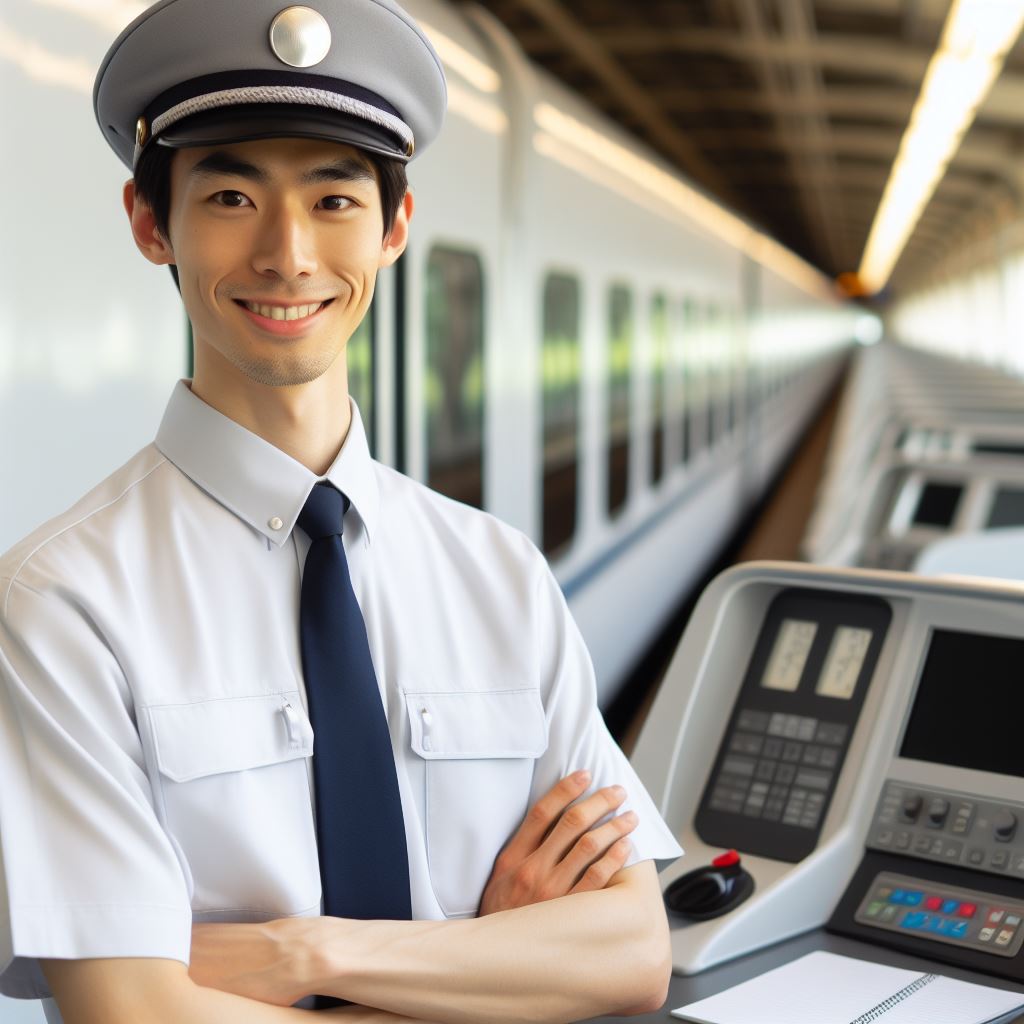Introduction
New Zealand’s rail network plays a vital role in the country’s transportation system, connecting major cities and rural areas.
This blog post aims to provide a train operator’s perspective on the challenges and opportunities associated with operating trains in New Zealand.
The rail network in New Zealand spans across both the North and South Islands, covering approximately 4,000 kilometers of tracks.
It is primarily owned and operated by KiwiRail, the national rail operator.
Purpose of the blog post
The purpose of this blog post is to shed light on the intricate workings of the rail network from a train operator’s viewpoint.
It will explore the daily operations, maintenance challenges, and the importance of collaboration with other stakeholders to ensure a smooth and efficient train service.
By offering an insider’s perspective, readers can gain a deeper understanding of the complexities involved in running a train service in New Zealand.
It will also highlight the efforts made by train operators to enhance safety, infrastructure, and customer experience.
Throughout this blog post, specific initiatives, such as upgrading tracks, using advanced technology for signaling, and investing in eco-friendly locomotives will be discussed.
The aim is to showcase the continuous commitment towards making the rail network more reliable, sustainable, and attractive for both passengers and freight.
In essence, this blog post serves as a comprehensive guide for anyone interested in learning about the inner workings of New Zealand’s rail network and the challenges faced by train operators in this unique and diverse landscape.
Stay tuned for the next chapters that delve into specific aspects of train operations and the future of rail in New Zealand.
Overview of Train Operators
In the world of train transportation, train operators play a vital role in the smooth functioning of the rail network.
Importance of Train Operators
Train operators are essential for ensuring the safe and efficient operation of trains.
They are responsible for transporting passengers and goods, making them the lifeblood of the rail network.
Personalized Career Consulting
Unlock your potential with expert career advice tailored to your goals. Get personalized guidance and actionable steps toward your dream career in New Zealand.
Get StartedTrain operators are the face of the railway system, providing a crucial link between the network and the public.
Without dedicated train operators, the rail network would come to a standstill, impacting the economy and people’s daily lives.
Responsibilities and Duties of Train Operators
Train operators are responsible for driving trains, following strict schedules and adhering to safety regulations.
They ensure the smooth operation of the train, making sure it is on time and reaches its destination efficiently.
Train operators must constantly monitor their surroundings, including signals, tracks, and potential hazards.
They communicate with control centers, maintaining constant updates on the train’s progress and any issues that may arise.
Train operators must be prepared to handle emergencies and make split-second decisions to ensure the safety of passengers and crew.
Customer service is also a key aspect of their duties, assisting passengers, answering inquiries, and providing a pleasant experience.
Training and Expertise Required
Becoming a train operator requires rigorous training and expertise in various aspects of railway operations.
Train operators typically complete a comprehensive training program that includes classroom instruction, simulations, and on-the-job training.
They must acquire a deep understanding of railway signaling systems, operational procedures, and emergency protocols.
Train operators need to have excellent communication skills, as they must interact with passengers, control centers, and other staff members.
Physical fitness is also essential, as train operators may need to navigate steep stairs, walk long distances, and handle heavy equipment.
Additionally, train operators must obtain appropriate licenses and certifications to ensure their competency in operating trains.
Transform Your Career with a Professional CV and Cover Letter
Stand out to employers with an ATS-optimized resume and tailored cover letter designed to match your dream role. Let us craft your job application materials for success!
Get StartedContinuous professional development is crucial for train operators to stay updated with industry advancements and regulatory requirements.
In fact, train operators are integral to the functioning of NZ’s rail network.
Their responsibilities, expertise, and dedication are crucial for maintaining safe and efficient train transportation.
Without them, the rail network would be unable to serve the public and contribute to the country’s economic growth.
Becoming a train operator requires a significant investment in training and acquiring the necessary skills, but the importance of their role cannot be understated.
Read: Skills Needed for Bus Drivers in New Zealand
NZ Rail Network Infrastructure
In this section, we will explore the infrastructure of New Zealand’s rail network, including a description of the network, the types of tracks and signaling systems used, and the challenges and maintenance requirements that rail operators face.
Description of the Rail Network Infrastructure in NZ
The rail network in New Zealand covers a vast expanse of land and plays a crucial role in facilitating the transportation of goods and passengers across the country.
It consists of a network of tracks, terminals, signaling systems, and other key elements.
The tracks are typically made of steel rails that are laid on wooden or concrete sleepers.
These tracks provide a stable foundation for the trains to travel along.
The length of the tracks varies depending on the geographic location and the purpose of the rail line, whether it is for freight or passenger transport.
The signaling systems are vital for ensuring the safe and efficient operation of the rail network.
These systems include trackside signals, which indicate to train operators when to proceed, stop, or slow down.
Boost Your Career with a Standout LinkedIn Profile
Attract recruiters and expand your network with a fully optimized LinkedIn profile tailored to highlight your strengths and professional goals. Let your profile open doors to new opportunities!
Get OptimizedThey also include train detection systems that can detect the presence of trains on the tracks and communicate this information to control centers.
Types of Tracks, Signaling Systems, and Other Key Elements
New Zealand’s rail network features a variety of track types to accommodate different train speeds and load capacities.
These include mainline tracks, which are designed for high-speed trains and heavy freight trains, and branchline tracks, which serve rural or less busy areas.
The signaling systems used in NZ include traditional mechanical signaling as well as modern electronic signaling systems.
Mechanical signaling uses physical devices, such as signal posts and levers, to display indications to train operators.
Electronic signaling systems use computers and electronic devices to transmit signals and control train movements.
Other key elements of the rail network infrastructure include terminals and interchanges, where passengers and freight can be loaded and unloaded.
These facilities are equipped with platforms, ramps, and cargo handling equipment to facilitate smooth and efficient transfers.
Challenges and Maintenance Requirements
Maintaining the rail network infrastructure in New Zealand presents several challenges.
The country’s diverse terrain, including mountainous regions and coastal areas, require specialized engineering solutions to build and maintain tracks that can withstand harsh weather conditions.
Additionally, as the rail network ages, regular maintenance and upgrading are necessary to ensure its safe and efficient operation.
This includes replacing worn-out tracks and sleepers, repairing signaling systems, and maintaining platforms and terminals to meet the needs of passengers and freight transport.
Another challenge is the coordination of maintenance activities to minimize disruption to train services.
Rail operators carefully plan maintenance schedules and sometimes have to redirect train traffic or make temporary adjustments to minimize the impact on passengers and freight movements.
In fact, the rail network infrastructure in New Zealand is a complex and extensive system that supports the transportation of people and goods across the country.
It consists of various types of tracks, signaling systems, terminals, and other key elements that require regular maintenance and upgrades to ensure safe and efficient operations.
Read: Career Path: Becoming a Train Operator in NZ
Role of Train Operators in Safety
Ensuring passenger and crew safety
Train operators play a crucial role in ensuring the safety of both passengers and crew members.
They are responsible for implementing protocols for emergency situations and ensuring compliance with safety regulations and guidelines.
One of the primary responsibilities of train operators is to ensure the safety of the passengers and crew members onboard.
This includes regularly inspecting the trains and their equipment to identify any potential hazards or mechanical issues.
Protocols for emergency situations
In emergency situations, train operators are trained to follow a set of protocols to ensure the safety and well-being of everyone on board.
This includes promptly communicating with the appropriate authorities and initiating emergency response procedures to minimize the impact of the situation.
Compliance with safety regulations and guidelines
Compliance with safety regulations and guidelines is of utmost importance for train operators.
They must stay up to date with the latest safety standards and properly implement them in their daily operations.
This includes ensuring that trains are in proper working condition, conducting regular safety checks, and adhering to speed limits and signaling systems.
In addition to the safety of passengers and crew members, train operators are also responsible for the safety of the surrounding communities.
They must operate the trains in a manner that minimizes noise pollution, ensures the safety of pedestrians and vehicles at crossings, and avoids any potential harm to the environment.
To fulfill their role effectively, train operators undergo extensive training and obtain the necessary certifications.
This includes training on operating the trains, emergency procedures, and safety protocols.
They are also trained to handle critical situations and make quick decisions to ensure the safety of everyone on board.
Key responsibilities of train operators in ensuring safety
- Regularly inspect trains
- Identify potential hazards
- Implement protocols for emergencies
- Communicate with authorities during emergencies
- Ensure compliance with safety regulations and guidelines
- Maintain proper working condition of trains
- Conduct regular safety checks
- Adhere to speed limits and signaling systems
- Minimize noise pollution
- Ensure safety at crossings
- Avoid harm to the environment
- Undergo extensive training and obtain necessary certifications
In short, train operators have a vital role in ensuring the safety of both passengers and crew members.
They must ensure compliance with safety regulations, implement protocols for emergencies, and undergo extensive training to fulfill their responsibilities effectively.
Read: Navigating NZ’s Transport: Bus Driver Insights

Operation of Trains
Preparing for a train journey
- Train operators start by inspecting the train’s mechanical systems, checking brakes, lights, and doors.
- They ensure that the train is fueled up and that there is enough fuel for the intended journey.
- Operators also perform a comprehensive safety check, inspecting emergency equipment and communication systems.
- They review the train’s schedule and route, ensuring they have a clear understanding of the journey ahead.
Roles and responsibilities during train operation
- Train operators are responsible for safely and efficiently operating the train during its journey.
- They must follow all safety protocols and regulations, including adhering to speed limits and signaling systems.
- Operators constantly monitor the train’s performance, ensuring it runs smoothly and addressing any issues promptly.
- They communicate with passengers, providing information about the journey and addressing any concerns or questions.
Coordinating with station staff, signalers, and maintenance crews
- Train operators collaborate closely with station staff to ensure a smooth boarding and disembarking process for passengers.
- They communicate with signalers to receive important information about track conditions and any potential obstacles.
- Operators work closely with maintenance crews, reporting any mechanical issues and coordinating necessary repairs.
- Efficient communication between operators, station staff, signalers, and maintenance crews is crucial for a safe and efficient train operation.
In general, train operators play a vital role in the operation of trains.
They must prepare thoroughly for each journey, fulfill their responsibilities during operation, and coordinate effectively with various personnel.
Their commitment to safety and efficiency contributes to the overall success of NZ’s rail network.
Read: Train Operator Roles in NZ: A Complete Guide
Daily Challenges Faced by Train Operators
In the fast-paced world of train operations, train operators face a unique set of challenges on a daily basis.
Their ability to handle these challenges efficiently and effectively is crucial to ensuring the safety and smooth functioning of New Zealand’s rail network.
Dealing with unforeseen issues and delays
One of the most common challenges train operators encounter is dealing with unforeseen issues and delays.
Whether it’s a technical glitch or a signal failure, these unexpected events can disrupt schedules and create frustration for both operators and passengers.
Train operators must quickly assess the situation, communicate with relevant personnel, and make necessary adjustments to minimize the impact on the overall operation.
Managing operational disruptions
Managing operational disruptions is another major challenge that train operators face.
This can range from track maintenance to accidents or incidents on the network.
Train operators must be prepared to handle these disruptions by coordinating with maintenance crews, emergency services, and other relevant stakeholders.
They need to ensure that the necessary resources and personnel are deployed promptly to address the situation and restore normalcy as soon as possible.
Balancing time constraints and safety measures
Balancing time constraints and safety measures is a constant struggle for train operators.
On one hand, they are under pressure to adhere to strict schedules and meet customer expectations.
On the other hand, safety must always remain the top priority.
Train operators must make quick decisions and judgment calls to avoid rushing and compromising safety standards.
They need to strike a delicate balance between efficiency and caution, ensuring that operations run smoothly while minimizing the risk of accidents and incidents.
Addressing these challenges
To overcome these challenges, train operators rely on a range of strategies and tools.
Effective communication is essential, both within the train operator team and with external stakeholders such as maintenance crews and control centers.
Regular training and drills help operators stay prepared for different scenarios and improve their decision-making abilities.
Technological advancements such as real-time monitoring systems and predictive maintenance solutions also play a crucial role in identifying and addressing potential issues before they escalate.
Additionally, train operators prioritize collaboration and cooperation with other industry players.
They actively engage with rail network managers, maintenance providers, and relevant authorities to exchange information, share best practices, and coordinate efforts in managing disruptions.
This collaborative approach not only streamlines operations but also enhances the overall resilience and efficiency of the rail network.
In review, train operators face numerous challenges in their daily operations.
Dealing with unforeseen issues and delays, managing operational disruptions, and balancing time constraints and safety measures are just some of the hurdles they must navigate.
However, through effective communication, regular training, and collaboration, these challenges can be overcome, ensuring the safe and efficient functioning of New Zealand’s rail network.
Technology and Innovation in Train Operations
Introduction of new technologies
Advancements in train technology have revolutionized the rail industry.
New technologies like high-speed trains and magnetic levitation (maglev) trains have been introduced.
These technologies have improved speed, efficiency, and safety in train operations.
Automatic train control systems have been implemented to regulate train movements and reduce the risk of collisions.
Communication-based train control systems have enhanced communication between trains, signaling systems, and control centers.
Impact of automation and digitization
Automation has played a significant role in train operations, making them more reliable and efficient.
Automatic train operation systems allow trains to operate without constant human intervention.
Digitization has led to the development of smart trains equipped with sensors, cameras, and data analysis capabilities.
Remote monitoring and maintenance systems have improved train maintenance processes.
Automated ticketing systems and online booking platforms have enhanced passenger convenience.
Improving efficiency and enhancing the passenger experience
New technologies have increased train speeds, reducing travel times and making rail transport more competitive.
Efficient scheduling algorithms and real-time information systems help minimize delays and disruptions.
Improved passenger information systems keep travelers informed about delays, platform changes, and connecting trains.
Enhanced onboard amenities, such as Wi-Fi connectivity and entertainment systems, improve the passenger experience.
Train operators have also implemented customer feedback systems to continuously improve their services.
Technology and innovation have greatly transformed train operations, improving efficiency, safety, and passenger experience.
The introduction of new technologies, such as high-speed trains and automatic train control systems, has revolutionized the rail industry.
Automation and digitization have further enhanced train operations, enabling trains to operate autonomously and providing smart features for passengers.
These advancements have led to increased efficiency, reduced travel times, and improved convenience for passengers.
With the integration of smart technologies, trains now offer amenities like Wi-Fi connectivity and entertainment systems, elevating the overall passenger experience.
Additionally, efficient scheduling algorithms and real-time information systems help reduce delays, making rail transport a reliable mode of transportation.
Train operators continuously strive to enhance their services by implementing customer feedback systems, ensuring that the evolving needs of the passengers are met.
Overall, technology and innovation play a vital role in shaping the future of train operations and the rail network in New Zealand.
Future of Train Operations in NZ
Potential growth and expansion of the rail network
- The rail network in NZ has the potential for significant growth and expansion in the coming years.
- With increasing demand for sustainable transportation options, rail travel is becoming more popular.
- Investment in rail infrastructure can help reduce road congestion and decrease carbon emissions.
- Improvements in technology and railway systems can enhance the efficiency and reliability of train operations.
- Expansion of the rail network can connect more regions and facilitate economic growth across the country.
Upcoming projects and initiatives
Several upcoming projects aim to enhance the train operations in NZ and meet the growing demand.
One such project is the City Rail Link in Auckland, which will improve connectivity and increase train frequencies.
Other initiatives focus on electrifying the rail network, improving tracks, and upgrading rolling stock.
The development of high-speed rail corridors is also being considered to reduce travel times between major cities.
These projects and initiatives demonstrate the commitment to the future of train operations in NZ.
Importance of train operators in the future of NZ’s rail
- Train operators play a crucial role in ensuring safe, efficient, and reliable train services.
- They are responsible for operating trains, following schedules, and maintaining high safety standards.
- Train operators contribute to customer satisfaction by providing a comfortable and enjoyable travel experience.
- With the expansion of the rail network, the demand for skilled train operators is expected to increase.
- They will play a vital role in managing the growing number of train services and ensuring their smooth operation.
In a nutshell, the future of train operations in NZ looks promising with potential growth and expansion of the rail network.
Upcoming projects and initiatives, such as the City Rail Link, electrification, and high-speed rail corridors, highlight the commitment towards improving train operations.
Train operators will remain key players in the future, ensuring the safety, efficiency, and customer satisfaction of train services across the country.
With their skills and expertise, they will help shape the future of NZ’s rail network as it evolves to meet the changing transportation needs of the population.
Conclusion
Let’s delve deeper into the significance of NZ’s rail network.
Throughout our discussion, we’ve highlighted its pivotal role in transportation, sustainability, and economic development.
This intricate system wouldn’t function seamlessly without the dedication and expertise of train operators.
They’re the backbone, ensuring efficiency, safety, and reliability in every journey.
It’s essential to express our profound appreciation for their tireless efforts, professionalism, and commitment.
Their contribution is invaluable, shaping the landscape of transportation in New Zealand.
To those intrigued by this dynamic industry, there’s much to explore and understand.
Delve into the complexities, challenges, and innovations that drive the sector forward.
By gaining insight into the intricacies of rail operations, you’ll develop a deeper appreciation for its significance.
The future of NZ’s rail network is promising, with opportunities for growth, sustainability, and innovation.
Embrace the journey, engage with the industry, and contribute to its ongoing success.
Together, let’s ensure that New Zealand’s rail network continues to thrive, connecting communities and driving progress across the nation.




